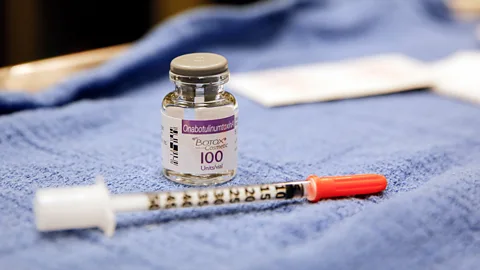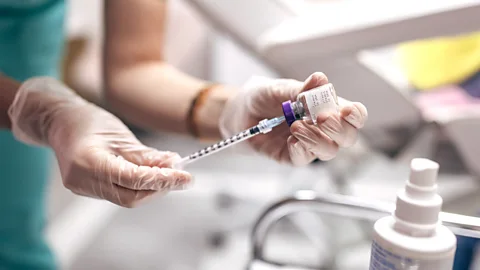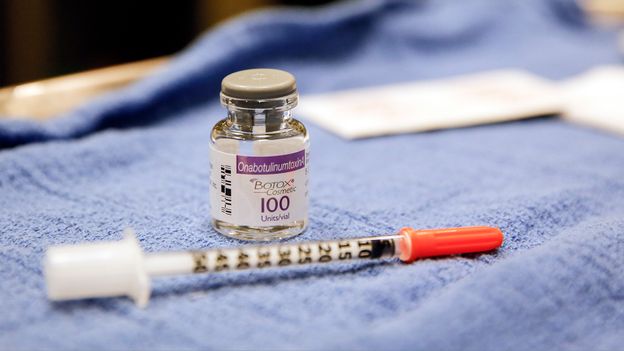

Botox is a common – and largely safe – cosmetic treatment. But it has emerged that there may be some permanent effects from long-term use.
A safe and surefire way to smooth wrinkles and fine lines? Or a toxin that sets your features into a permanent “frozen” expression? Either way, Botox is big business.
Botox (brand name for botulinum neurotoxin) is the most common cosmetic procedure performed worldwide, with nearly three million injections estimated to be performed each year. Originally derived from a powerful neurotoxin produced by bacteria, it works by blocking signals from the nerves that control facial muscles. Muscles relax and fine lines and wrinkles disappear. The result? A more youthful look – for three to four months, at least.
Most reported side effects are minor and transient. They include pain, swelling or mild bruising at the injection site and headache and flu-like symptoms for the first 24 hours. Temporary weakness and drowsiness in the face can also sometimes happen.


However, more severe reactions have sometimes been observed. In April 2024, the US Centers for Disease Control and Prevention (CDC) issued a warning that 22 women between the ages of 25 and 59 had recently reported “adverse reactions” in falsification or misuse of botox.
Eleven people were hospitalized and six were treated with antitoxin due to concerns about botulism – a condition where the toxin spreads beyond the local area and attacks the central nervous system causing muscle paralysisdifficulty breathing, even death.
Reported symptoms included blurred and double vision, droopy eyelids, difficulty swallowing, slurred speech, difficulty breathing, fatigue and weakness. All 22 incidents occurred after the women received Botox injections from unlicensed or untrained individuals in places that were not health care facilities.
“The CDC, FDA [Federal Drug Administration]and jurisdictional partners are actively investigating these illnesses that occurred after injecting misused or adulterated botulism toxin,” says Michelle Waltenburg, an epidemiologist in CDC’s Division of Epidemiology of Epidemiologic Diseases.
But how common are side effects like these?
“If botulinum toxin is made correctly and comes from a good brand, the potency is such that even if it spreads a little, it doesn’t cause a huge number of side effects,” says Ash Mosahebi, professor of plastic surgery at University College London.
“The dose is extremely low. This amount of toxin cannot cause botulism in humans. However, the problem we’ve had is that there are incorrect counterfeit versions circulating. They are poorly made and poorly controlled.”


What is Botox?
Botulism neurotoxins are highly lethal poisons produced by bacteria Clostridium botulinum. They enter the neurons and bind to the vesicles that carry the neurotransmitter acetylcholine (Ach), preventing its release.
As Ach causes muscle contraction, botulism toxins cause muscle paralysis. There are seven distinct forms of botulinum toxin, the AG types.
So fake botox is bad news. But what about the safety of regular botulinum toxin? ONE study 2020 reviewed the safety of Botox cosmetic injections and concluded that reports of serious side effects like those seen by the CDC were rare. For example, only between 2002-03 36 serious side effects were reported to the FDA regarding cosmetic use, with the majority concerning difficulty swallowing. The risk of serious side effects was 33 times higher for therapeutic uses of Botox rather than cosmetic cases (Botox is sometimes used to treat migraines, neck spasms, sweating, overactive bladder, lazy eye, and other conditions).
However, side effects may simply not be reported. ONE Study 2023 by Mosahebi and colleagues at UCL found that 69% of respondents to a survey had experienced long-term side effects such as pain, anxiety and headaches from Botox. There were also serious psychological and emotional consequences for patients when procedures went wrong.
“If administered incorrectly, you can have a kind of drooping of your eyelids, and that can last for six months,” says Mosahebi.
“It can lead to embarrassment at work and affect your confidence in a way that is potentially long-lasting.”
Long term results
Very little is known about the long-term health effects of getting Botox, as most clinical trials only follow patients for about six months. However, some studies have found that long-term cosmetic use of botulinum toxin can cause permanent changes in facial expression, with individuals no longer able to flex their facial muscles. ONE 2022 review study found that people who received regular Botox injections showed changes in their muscle composition, function and appearance up to four years after their last injection.
“If you didn’t use your abs [abdominal muscles] for 10 years, they would waste,” says Mosahebi.
“So, in a similar way, if the muscle that makes your face crease doesn’t get used or is paralyzed with Botox, after a while it’s not as strong as it was before, so you have less expression.”
It is even possible that the Botox toxin could escape from its location in the nerve terminal near the muscle and travel to the wider central nervous system. In 2015, scientists led by Frederic Meunier at the University of Queensland in Australia used cutting-edge microscopes to look at individual botulism toxin molecules traveling at high speed along rat neurons (nerve cells). Previously, it was thought that botulinum toxin would remain in the nerve terminal portion of the neuron—where neurotransmitter release occurs—before being degraded. However, this was not the case.
“We watched some of the toxin molecules enter the nerve terminal and be transported along the axon all the way back to the cell body for degradation.” says Meunier.


Some carried escaped toxins to other neurons through an unknown mechanism.
“The only other toxin that we know of that can do this is tetanus toxin, which can travel all the way along the motor neurons to the spinal cord and block transmission there,” says Meunier.
It’s important to note, however, that the concentrations of botulinum toxin used in the study were much higher than would ever be used in Botox injections, Meunier adds.
“To people, I think the idea of this [the toxin] Getting back up to the central nervous system and having an effect there is unlikely.”
However, there is some evidence that long-term use of Botox could have a psychological impact on patients. In a 2023 study, Mitchell Brin, a neurologist at the University of California, Irvine, and colleagues scan the brains of 10 women before and after botox injections. During functional MRI scans of their brains, they showed subjects pictures of angry and happy faces interspersed with neutral pictures. In the post-Botox scan, the women showed altered activity in two brain regions known to play a role in emotion processing: the amygdala and the fusiform gyrus.
This fits with his findings other studieswho have shown that receiving Botox injections can make it harder to recognize and process the emotions of others.
According to Brin, the explanation could be due to how our brains recognize other people’s emotions. For example, when we see expressions of joy or sadness in others, we unconsciously copy them using our own facial muscles. This helps us understand and interpret how others feel.
But because Botox paralyzes the facial muscles, we can no longer mimic other people’s faces, making us potentially less empathetic.
So what can people do to minimize the risks of getting Botox? First, people should only receive Botox injections from licensed providers who are trained in how to administer it, and ideally in a healthcare setting.
Allergan Aesthetics, the makers of Botox, said in a statement to BBC Future that users should ensure they only undergo procedures with an authorized medical practitioner.
A company spokesperson added: “Our priority is patient health and safety and all reports of counterfeit products are thoroughly investigated by our team and in cooperation with law enforcement and regulatory authorities.
“We have a rigorous and sophisticated manufacturing and distribution process to ensure product quality and authenticity, including strict anti-counterfeiting features.”
Mosahebi recently conducted an analysis of the injectable cosmetic industry in the UK and found that 68% of cosmetic professionals who administer injections such as Botox are not doctors.
But if administered correctly, there is every reason to believe that Botox is largely safe.
“It’s really widely used and the safety profile is excellent,” says Meunier.
“There have been some people who have had adverse effects, but you have to put that in the context of the millions of people who have taken this toxin since the 1980s and ’90s.”



